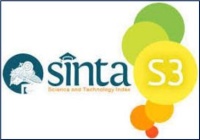Evaluasi Kemampuan Literasi Biodiversitas Mahasiswa
Abstract
Keywords
Full Text:
PDFReferences
Anne Marie anDam Fleming. (1996). The Development of An Instrument For Evaluating World Wildlife Fund’s Windows on The Wild Biodiversity Education Program.
Aripin, I. (2023). Online Citizen Science to Develop Local Species Identification Skills and Biodiversity Awareness of Prospective Biology Teacher Students. In Symposium of Biology Education (Symbion). https://doi.org/10.26555/symbion.11742
Aslan Efe, H., & Efe, R. (2022). An Investigation of Secondary School Students’ Biodiversity Literacy Level. Dinamika Ilmu, 393–410. https://doi.org/10.21093/di.v22i2.5046
Delector, R. T. (2023). Students’ Knowledge and Attitude towards Biodiversity Conservation. Asian Journal of Biodiversity, 14(1). https://doi.org/10.7828/ajob.v14i1.1548
Derman, M., Gör Ars, Mürset Çakmak, & Hasan Gürbüz. (2012). Investigation Of Preservi Ce Teachers’ Biodiversity Literacy. The Journal of Academic Social Science Studies, 5(7), 279–289.
Efe Hülya Asan and Rifat Efe. (2022). A Biodiversity Literacy Assessment Instrument Adaptation Study for Middle School Students. Journal of Computer and Education Research, 10(20), 672–692.
Fajri, S. R., Sudiatmika, A. R., Suma, I. K., & Suardana, I. N. (2023). Studi Meta Analisis: Peningkatan Kemampuan Literasi Biodiversitas Berdasarkan Model Pembelajaran Dan Tingkat Pendidikan. Bioscientist: Jurnal Ilmiah Biologi, 11(2), 899. https://doi.org/10.33394/bioscientist.v11i2.7688
Harmadji, D. E., Hastutik, S., Leksono, S., & Mamduh, A. (2022). Impact of Deforestation on Forestry and Forest Village Community Institution (Lmdh). In Indonesian Journal of Multidisciplinary Science. https://doi.org/10.55324/ijoms.v1i9.167
Huffling, L. D., & Stevenson, A. D. (2019). Connecting biodiversity, literacy, and culturally responsive pedagogy. digitalcommons. Georgiasouthern https://digitalcommons.georgiasouthern.edu/teach-secondary-facpres/211/
Janžekovič, B. (2022). Insights into Biodiversity Literacy. The American Biology Teacher, 84(8), 456–458. https://doi.org/10.1525/abt.2022.84.8.456
Katili Abubakar Sidik; Ramli Utina; Frida Marati Yusup; dan Masrid Pikoli. (2022). Literasi Biodiversitas. Ideas Publishing.
Lee, J. S. H., Abood, S. A., Ghazoul, J., Barus, B., Obidzinski, K., & Koh, L. P. (2013). Environmental Impacts of Large‐Scale Oil Palm Enterprises Exceed That of Smallholdings in Indonesia. In Conservation Letters. https://doi.org/10.1111/conl.12039
Lubos, L. C. (2023). Biodiversity Literacy Level of Public Administration Students in a Higher Education Institution. Asian Journal of Biodiversity. https://doi.org/10.7828/ajob.v14i1.1544
Maryanto Ibnu, Maharadatunkamsi, Anang Setiawan Achmadi, Sigit Wiantoro, Eko Sulistiadi, Masaaki Yoneda, Agustinus Suyanto, and J. S. (2019). Checklist of The Mammals of Indonesia (Third Edit). Research Center For Biology, Indonesia Institute of Science (LIPI).
Moss, A., Gusset, M., & Jensen, E. A. (2014). A Global Evaluation of Biodiversity Literacy in Zoo and Aquarium Visitors. https://www.researchgate.net/publication/266444881
Nidh, S. (2021). Economic and ecological importance of wildlife. 3(2), 2021.
Nyamasyo, S., & Kihima, B. O. (2014). Changing Land Use Patterns and Their Impacts on Wild Ungulates in Kimana Wetland Ecosystem, Kenya. International Journal of Biodiversity. https://doi.org/10.1155/2014/486727
ÖZDEMİR, A. M. (2020). Investigation of Primary School Candidates’ Views on Biodiversity. International Journal of Eurasian Education and Culture, 5(10), 1145–1165. https://doi.org/10.35826/ijoecc.247
Sarbaini, S., & Fahlevi, R. (2022). Tingkat Kompetensi Kewarganegaraan Ekologis Guru Pendidikan Pancasila Dan Kewarganegaraan Di Sekolah Menengah Pertama. Jurnal Moral Kemasyarakatan. https://doi.org/10.21067/jmk.v7i2.7674
Siahaan, P., & Saroyo, S. (2019). Pelatihan Identifikasi Satwa Kunci Sulawesi Bagi Siswa Sekolah Menengah Kota Manado Di Taman Wisata Alam Batuputih, Kota Bitung, Sulawesi Utara. Vivabio Jurnal Pengabdian Multidisiplin. https://doi.org/10.35799/vivabio.1.3.2019.26812
Slamet Khoiri. (2019). Satwa Liar Indonesia. Http://Profauna.Net/Id.
Tekin, N., & Aslan, O. (2022). Analysis of Pre-Service Science Teachers’ Biodiversity Images According to Sustainable Environmental Awareness. In Present Environment and Sustainable Development. https://doi.org/10.47743/pesd2022161005
Tergenbayeva, Z., Karasholakova, L., Çatar Sarıkurt, B., Özdilek, Z., Atasoy, E., & Kitapbayeva, A. (2024). Investigation of Pre-Service Science Teachers’ Knowledge Levels, Practical Experiences, and Perceived Competencies in Teaching Biodiversity. In Journal of Turkish Science Education. https://doi.org/10.36681/tused.2023.039
Trinirmalaningrum, Nurdiyansah, D., & Jojo, R. (2016). Potret Perdagangan Ilegal Satwa Liar di Indonesia. Perkumpulan SKALA. www.PerkumpulanSKALA.net
Tupas, F. P. (2019). Nature Feature: The Use of Local Biodiversity in Science Pedagogy. In African Educational Research Journal. https://doi.org/10.30918/aerj.73.19.025
Wallhagen, M., Eriksson, O., & Sörqvist, P. (2018). Gender Differences in Environmental Perspectives among Urban Design Professionals. Buildings, 8(4), 59. https://doi.org/10.3390/buildings8040059
Zhang, J. W., Howell, R. T., & Iyer, R. (2014). Engagement with natural beauty moderates the positive relation between connectedness with nature and psychological well-being. Journal of Environmental Psychology, 38, 55–63. https://doi.org/10.1016/j.jenvp.2013.12.013
DOI: https://doi.org/10.33394/bioscientist.v12i2.14208
Refbacks
- There are currently no refbacks.

This work is licensed under a Creative Commons Attribution-ShareAlike 4.0 International License.

Bioscientist : Jurnal Ilmiah Biologi is licensed under a Creative Commons Attribution-ShareAlike 4.0 International License
Editorial Address: Pemuda Street No. 59A, Catur Building Floor I, Mataram City, West Nusa Tenggara Province, Indonesia











